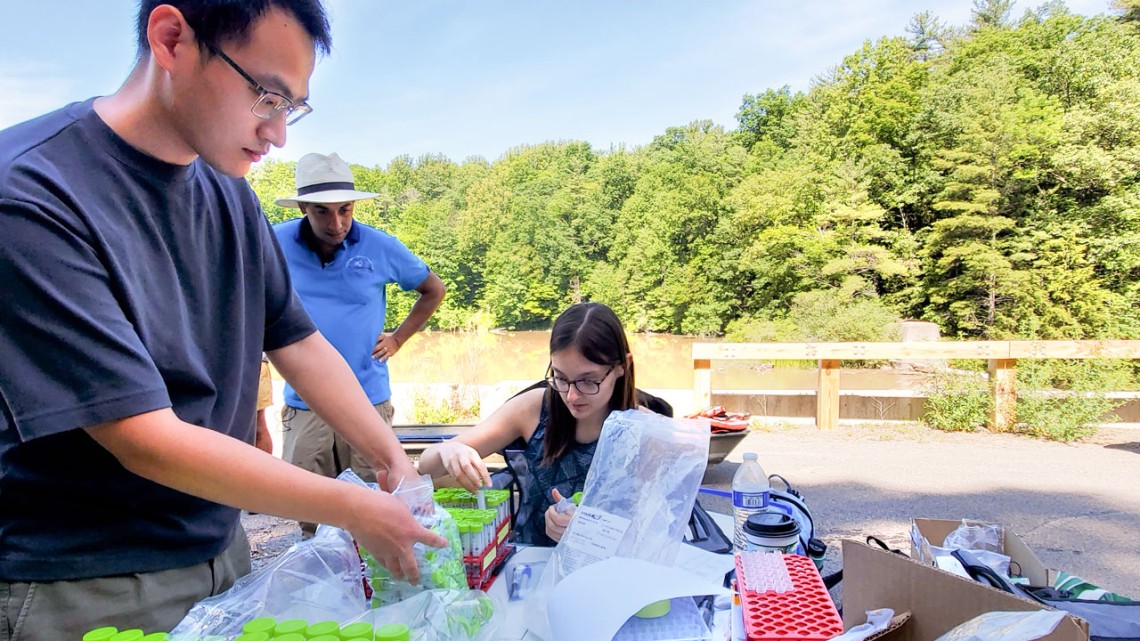
Doctoral student Yi Sang, left, and Olivia Pietz ’22 prepare water samples at the Ithaca City reservoir last summer, as Professor Matt Reid observes the work.
Students’ tool forecasts manganese in Ithaca water supply
By Blaine Friedlander
As Ithaca summers become hotter and drier, higher concentrations of the element manganese occur in the city’s water supply, creating challenges for the city’s water treatment plant and raising potential health concerns.
To help the Ithaca Water Treatment Plant, Cornell engineering students have developed a forecasting tool, using an ARIMA – autoregressive integrated moving average model – approach to predict concentrations of manganese in the reservoir to support treatment decisions made by treatment plant staff.
“We are providing a forward-looking model to predict manganese concentrations, so the water treatment professionals can estimate levels several hours or perhaps a few days into the future,” said Matthew Charles Reid, assistant professor of civil and environmental engineering in the College of Engineering, who led the student project.
Reid and Yi Sang, a doctoral student in civil and environmental engineering, will present the software tool and other suggestions Feb. 23 to the treatment plant’s administrators and engineers.
Six Mile Creek supplies Ithaca’s water. A 60-foot dam, built as a reservoir in 1912 to create a stable water supply, remains in use today. The current water treatment plant, completed in 2017, can produce 4 million gallons of potable water daily, but on average, current production is about 2.5 to 3 million gallons daily.
Thanks to warmer summers, the naturally occurring manganese – released from minerals in the glacial Finger Lakes landscape – concentrates on hot calm days in the lower, low-oxygen depths of the stratified reservoir, according to Reid.
Rain is always welcome. If it rains, the reservoir gets a much-needed mix and water stratification breaks up, Reid said. However, if stratification occurs and there’s no rain in sight, anoxic conditions develop near the bottom of the reservoir – where the water-intake is located.
Sang and his student colleagues developed a model that incorporates statistical relationships, anticipated weather and autoregression – a mathematical formula often run in the financial world – so water treatment facility professionals could better predict the manganese concentrations up to three days into the future.
“It allows people at the treatment to plug in key numbers and measurements, and the output will be a sense of manganese conditions in a half-day, a full day or two days from now,” Sang said
Reid, who is also a faculty fellow at the Cornell Atkinson Center for Sustainability, said the team is not modeling the detailed physics of the reservoir’s stratification, but is instead using statistical modeling to predict manganese concentrations based on weather factors known to affect stratification. “We’re not going into physical detail. We're more taking a statistical approach,” he said.
In addition to Reid and Sang, the team includes undergraduate students Emily Christiansen ’23 and Olivia Pietz ’22; and Christopher Sinton, associate professor, environmental studies and science, Ithaca College, and his students.
The work was done in close collaboration with Roxanna Johnston, the watershed coordinator for the City of Ithaca, and it was supported by Cornell’s David M. Einhorn Center for Community Engagement and the New York State Water Resources Institute in the College of Agriculture and Life Sciences.
Get Cornell news delivered right to your inbox.
Subscribe
